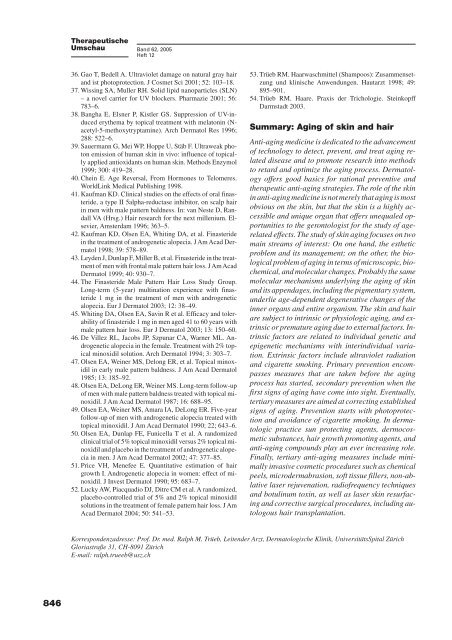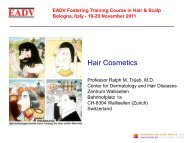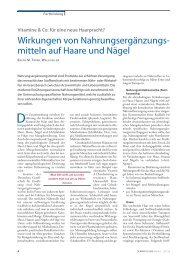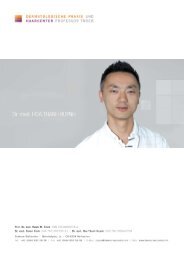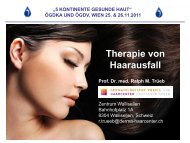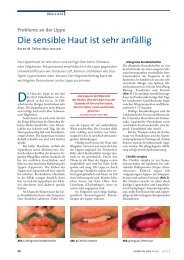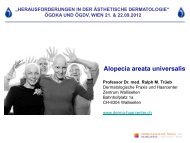Haut und Haar - Dermatologische Praxis und Haarcenter Professor ...
Haut und Haar - Dermatologische Praxis und Haarcenter Professor ...
Haut und Haar - Dermatologische Praxis und Haarcenter Professor ...
Erfolgreiche ePaper selbst erstellen
Machen Sie aus Ihren PDF Publikationen ein blätterbares Flipbook mit unserer einzigartigen Google optimierten e-Paper Software.
846<br />
Therapeutische<br />
Umschau Band 62, 2005<br />
Heft 12<br />
36. Gao T, Bedell A. Ultraviolet damage on natural gray hair<br />
and ist photoprotection. J Cosmet Sci 2001; 52: 103–18.<br />
37. Wissing SA, Muller RH. Solid lipid nanoparticles (SLN)<br />
– a novel carrier for UV blockers. Pharmazie 2001; 56:<br />
783–6.<br />
38. Bangha E, Elsner P, Kistler GS. Suppression of UV-induced<br />
erythema by topical treatment with melatonin (Nacetyl-5-methoxytryptamine).<br />
Arch Dermatol Res 1996;<br />
288: 522–6.<br />
39. Sauermann G, Mei WP, Hoppe U, Stäb F. Ultraweak photon<br />
emission of human skin in vivo: influence of topically<br />
applied antioxidants on human skin. Methods Enzymol<br />
1999; 300: 419–28.<br />
40. Chein E. Age Reversal, From Hormones to Telomeres.<br />
WorldLink Medical Publishing 1998.<br />
41. Kaufman KD. Clinical studies on the effects of oral finasteride,<br />
a type II 5alpha-reductase inhibitor, on scalp hair<br />
in men with male pattern baldness. In: van Neste D, Randall<br />
VA (Hrsg.) Hair research for the next millenium. Elsevier,<br />
Amsterdam 1996; 363–5.<br />
42. Kaufman KD, Olsen EA, Whiting DA, et al. Finasteride<br />
in the treatment of androgenetic alopecia. J Am Acad Dermatol<br />
1998; 39: 578–89.<br />
43. Leyden J, Dunlap F, Miller B, et al. Finasteride in the treatment<br />
of men with frontal male pattern hair loss. J Am Acad<br />
Dermatol 1999; 40: 930–7.<br />
44. The Finasteride Male Pattern Hair Loss Study Group.<br />
Long-term (5-year) multination experience with finasteride<br />
1 mg in the treatment of men with androgenetic<br />
alopecia. Eur J Dermatol 2003; 12: 38–49.<br />
45. Whiting DA, Olsen EA, Savin R et al. Efficacy and tolerability<br />
of finasteride 1 mg in men aged 41 to 60 years with<br />
male pattern hair loss. Eur J Dermatol 2003; 13: 150–60.<br />
46. De Villez RL, Jacobs JP, Szpunar CA, Warner ML. Androgenetic<br />
alopecia in the female. Treatment with 2% topical<br />
minoxidil solution. Arch Dermatol 1994; 3: 303–7.<br />
47. Olsen EA, Weiner MS, Delong ER, et al. Topical minoxidil<br />
in early male pattern baldness. J Am Acad Dermatol<br />
1985; 13: 185–92.<br />
48. Olsen EA, DeLong ER, Weiner MS. Long-term follow-up<br />
of men with male pattern baldness treated with topical minoxidil.<br />
J Am Acad Dermatol 1987; 16: 688–95.<br />
49. Olsen EA, Weiner MS, Amara IA, DeLong ER. Five-year<br />
follow-up of men with androgenetic alopecia treated with<br />
topical minoxidil. J Am Acad Dermatol 1990; 22; 643–6.<br />
50. Olsen EA, Dunlap FE, Funicella T et al. A randomized<br />
clinical trial of 5% topical minoxidil versus 2% topical minoxidil<br />
and placebo in the treatment of androgenetic alopecia<br />
in men. J Am Acad Dermatol 2002; 47: 377–85.<br />
51. Price VH, Menefee E. Quantitative estimation of hair<br />
growth I. Androgenetic alopecia in women: effect of minoxidil.<br />
J Invest Dermatol 1990; 95: 683–7.<br />
52. Lucky AW, Piacquadio DJ, Ditre CM et al. A randomized,<br />
placebo-controlled trial of 5% and 2% topical minoxidil<br />
solutions in the treatment of female pattern hair loss. J Am<br />
Acad Dermatol 2004; 50: 541–53.<br />
53. Trüeb RM. <strong>Haar</strong>waschmittel (Shampoos): Zusammensetzung<br />
<strong>und</strong> klinische Anwendungen. <strong>Haut</strong>arzt 1998; 49:<br />
895–901.<br />
54. Trüeb RM. <strong>Haar</strong>e. <strong>Praxis</strong> der Trichologie. Steinkopff<br />
Darmstadt 2003.<br />
Summary: Aging of skin and hair<br />
Anti-aging medicine is dedicated to the advancement<br />
of technology to detect, prevent, and treat aging related<br />
disease and to promote research into methods<br />
to retard and optimize the aging process. Dermatology<br />
offers good basics for rational preventive and<br />
therapeutic anti-aging strategies. The role of the skin<br />
in anti-aging medicine is not merely that aging is most<br />
obvious on the skin, but that the skin is a highly accessible<br />
and unique organ that offers unequaled opportunities<br />
to the gerontologist for the study of agerelated<br />
effects. The study of skin aging focuses on two<br />
main streams of interest: On one hand, the esthetic<br />
problem and its management; on the other, the biological<br />
problem of aging in terms of microscopic, biochemical,<br />
and molecular changes. Probably the same<br />
molecular mechanisms <strong>und</strong>erlying the aging of skin<br />
and its appendages, including the pigmentary system,<br />
<strong>und</strong>erlie age-dependent degenerative changes of the<br />
inner organs and entire organism. The skin and hair<br />
are subject to intrinsic or physiologic aging, and extrinsic<br />
or premature aging due to external factors. Intrinsic<br />
factors are related to individual genetic and<br />
epigenetic mechanisms with interindividual variation.<br />
Extrinsic factors include ultraviolet radiation<br />
and cigarette smoking. Primary prevention encompasses<br />
measures that are taken before the aging<br />
process has started, secondary prevention when the<br />
first signs of aging have come into sight. Eventually,<br />
tertiary measures are aimed at correcting established<br />
signs of aging. Prevention starts with photoprotection<br />
and avoidance of cigarette smoking. In dermatologic<br />
practice sun protecting agents, dermocosmetic<br />
substances, hair growth promoting agents, and<br />
anti-aging compo<strong>und</strong>s play an ever increasing role.<br />
Finally, tertiary anti-aging measures include minimally<br />
invasive cosmetic procedures such as chemical<br />
peels, microdermabrasion, soft tissue fillers, non-ablative<br />
laser rejuvenation, radiofrequency techniques<br />
and botulinum toxin, as well as laser skin resurfacing<br />
and corrective surgical procedures, including autologous<br />
hair transplantation.<br />
Korrespondenzadresse: Prof. Dr. med. Ralph M. Trüeb, Leitender Arzt, <strong>Dermatologische</strong> Klinik, UniversitätsSpital Zürich<br />
Gloriastraße 31, CH-8091 Zürich<br />
E-mail: ralph.trueeb@usz.ch


